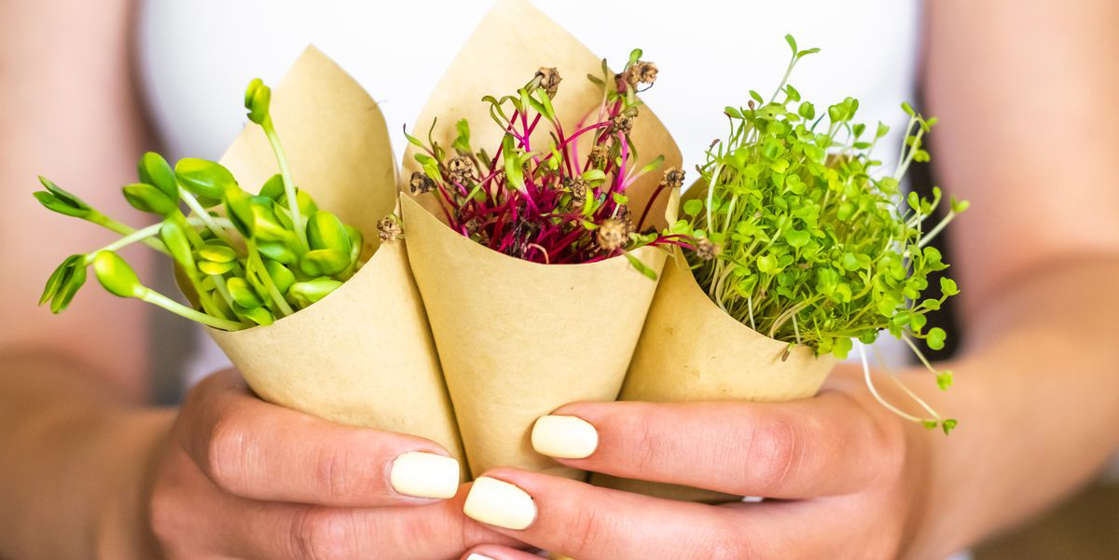Are Seemingly-Fancy Microgreens Worth Adding to Your Meals?

You already know that leafy greens like kale, spinach, and arugula, pack a major nutritional punch. And now the not-yet-mature versions of these veggies—what's known as microgreens—are popping up as a way to add more vitamins and minerals to your plate.
Microgreens have emerged as a much-loved garnish at restaurants and another piece of produce to pick up at your local grocery store. And not only do the dainty plants offer up visual appeal, but they are also full of punchy flavors and plenty of nutrition.
But are these itty-bitty leaves worth the splurge? Do runners need them to pack in more vegetables and pump up their nutrition for better health and performance? Or are microgreens just another over-hyped food fad that will do little more than leave a dent in your wallet?
We got to the bottom of whether microgreens should have a place on your grocery list and why they're proof that sometimes less is more. Read on before you make your next sandwich or salad.
What are microgreens, exactly?
“Microgreens” is a marketing term for vegetables and herbs that haven’t yet matured—the middle ground between sprouts and baby greens. For example, these include foods such as radishes, kale, and broccoli that are a long way off from reaching mature status, but instead are at the germination stage where they have two unfurled seed leaves called cotyledons. (In contrast, sprouts are germinated seeds that have cracked open and have grown what looks like white tails.)
Microgreens are harvested above the soil line when the plant is no taller than about 5 centimeters, which takes one to three weeks from when the seeds are sown. Tiny as they are, these young plants deliver intense flavors, vibrant colors, and unique textures.
Radish and mustard microgreens add a fiery punch; arugula will wake up taste buds with a peppery kick; and pea shoots taste like the freshest sun-kissed peas.
How healthy are microgreens?
Nutritionally, microgreens prove that great things can come in small packages.
“Research suggests that younger leaves of plants can have higher levels of certain vitamins and antioxidants than more mature plants,” says Sharon Palmer, R.D.N., author of The Plant-Powered Diet.
Research from the U.S. Department of Agriculture found that ounce for ounce, microgreens like cilantro and amaranth can be more concentrated in important nutrients including vitamin C, beta-carotene, and vitamin K than their grown-up versions.
For example, the microgreen version of red cabbage could give you a bigger shot of vitamin C—a nutrient that is essential for heart health—than what you’d get from the shredded stuff you find in bagged slaw mixes. Little nutrition-packed sprigs of broccoli are rife with sulforaphane, a potent cancer-battling compound. (When you chomp on broccoli sprouts, you activate an enzyme called myrosinase that converts the compound glucoraphanin in the broccoli sprouts into sulforaphane.)
In addition, microgreens contain a notable amount of dietary fiber to help keep you feeling full and improve your microbiome.
Why do they hit above their weight nutritionally? “Since microgreens are harvested when the plants are not yet mature, they’re rich in the nutrients and antioxidants needed to grow into full-blown plants,” says Palmer.
Nutrient and antioxidants levels can vary greatly among microgreens—growing, harvesting, and handling conditions may have a considerable impact on nutrient content—so Palmers says it can be a good idea to include a few different varieties in your diet to get a bigger range of nutrition.
Are there any downsides to microgreens?
You should not trade in your fully-grown heads of broccoli for a shopping cart full of microgreens. For most people, it would be hard (and crazy expensive if you aren’t growing your own) to get all their vegetable nutrition from microgreens, since portion sizes tend to be on the smaller size and shelf life is on the shorter end.
“It’s best to use them to complement your diet, and you certainly don’t have to choose all of your veggies in this form,” says Palmer.
In other words, go ahead and stuff some kale microgreens into your mid-day turkey and cheese wrap, but still make use of the grown-up leaves for your dinner salad.
How can you add microgreens to your diet?
Results of a study in the Journal of Food Science suggest that many consumers are intrigued by the flavors and appearance of microgreens and would be willing to include them more often in their meals. Luckily, versatile sprouts can be eaten in a variety of ways. Palmer suggests trying them out in sandwiches, wraps, and salads.
“I love them in homemade sushi rolls and as a garnish on a veggie burger or grain bowl,” she adds.
They can also perk up tacos, grilled cheese, avocado toast, omelettes, and scrambled eggs as a fanciful garnish. And blend them into dips, pesto, and green smoothies.
Microgreens may carry fewer food safety concerns than sprouts because they are grown in an environment with less moisture, and, unlike sprouts, the roots of microgreens are left behind during harvesting. With that said, they still should be rinsed before eating to reduce the risk of contamination from bugs such as salmonella and E. coli.
Where can you buy microgreens?
Expanding past alfalfa, microgreens ranging from daikon radish to amaranth are becoming increasingly available at natural food stores, farmers’ markets, and even some supermarkets. Choose those with jumpy looking greens—a sign they were recently harvested and are at peak flavor and nutrition. They should also smell fresh with no pungent odor. Definitely avoid any that are slimy, which could be a sign of bacterial growth.
Compared to regular vegetables, they can be shockingly pricey based on weight. You can likely buy an entire cabbage for the same price as a small bunch of the top-dollar micro version. (They can be cheaper if purchased from a local supplier at a farmers’ market, though.)
However, you can easily grow a plantation of microgreens year-round in your very own kitchen that will put a much smaller hole in your wallet—it’s about the easiest gardening project around, no green thumb required. It’s a great family project, too, as there is some evidence that growing vegetables can help encourage children to eat more of them and enjoy a more varied diet.
The post Are Seemingly-Fancy Microgreens Worth Adding to Your Meals? appeared first on Runner's World.

